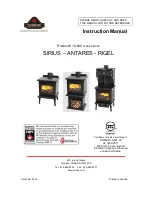
Emptying Ashes
Only empty ashes when the fire is cold. Use the tool or a glove to open the door. Stir the fire with a poker before lifting out the ashbin. Remember to let ash
cool before disposing in plastic sacks or dustbins. There is no need to empty every last speck but ash from mineral fuels should never be allowed to build up so
that it comes into contact with the underside of the grate.
Extended Burning
Our stoves are intended for quick heat-‐up intermittent use. While well capable of lasting for many hours, they are not designed for overnight burning. For best
extended burning results allow the fire to burn down to a low, hot, firebed and fully fill with a hard fuel such as anthracite (c30mm size is best) and set the air
controls to ‘low’.
Keeping the window clean
Simply operating the stove for a few minutes at high output will often burn off any deposits left by tarry or wet fuels. Severe stains can be removed when cold
with a domestic bleach cleaner. The window is not glass but a transparent ceramic, it may develop tiny hairline cracks, these are harmless and a characteristic of
the toughest heat-‐resistant material known. Reduce the risk of staining by using only very dry fuel and keeping the airwash ❷control at least a little open.
Opening the door
This stove is designed to be operated only with the door closed. The door handle can get very hot so use the poker tool or a glove. Open the door very slowly to
minimise fume emission and prevent hot fuel falling out.
Summer shut down
Before a long period of non-‐use, empty fuel and ash, remove the throat plate and leave all air controls open to allow ventilation and reduce condensation.
Fuels
There is no ‘perfect’ fuel so we strongly recommend that you try a selection of fuels (or mixtures) to find which
suits you best. Do avoid dusty materials such as sawdust, they can burn far too violently.
Smoke Control
In certain areas special rules apply to reduce smoke nuisance. Check with your local authority.
Wood
Wood only emits as much carbon to the atmosphere as the tree took in when growing so wood is considered
the ‘carbon neutral’ fuel. When wood is cut down its cells are full of water. Burning such wet or ‘green’ wood
wastes heat in making steam and produces flammable acidic tars which will cling to, and rapidly damage, your
stove and chimney. Split logs will typically take two years to become reasonably dry, round logs much longer.
Cracks in the ends, a hollow sound when tapped and bark falling away are all signs that a log may be ready for
use. The fine, white residue produced when wood burns is not ash, but the remains of cell walls which can burn if
kept hot enough, so don’t de-‐ash a fire until absolutely necessary when using wood.
These appliances are authorised for use in smoke control areas of the UK when burning wood. For best performance, and always for low smoke emission:
•
Split logs lengthways for drying
•
Use logs no bigger than about 100mm x 250mm
•
Ensure logs are absolutely dry (less than 15% moisture)
•
Fill the stove ‘criss-‐cross’ so air can circulate between logs
•
Fill ‘little & often’
•
Always have the airwash control ❷ at least a little open
•
When first lighting, or reviving a fire from embers, use only very small, thin, dry, sticks
•
Never operate with the door open
•
Don’t overfill the firebox
Joinery Waste
Dry wood offcuts will burn well, but don’t expect softwood waste to burn as cleanly or for as long as hardwood logs.
Peat
(Not smokeless in the UK. Smokeless in the RoI) Sod turf must be thoroughly dry.
Lignite
(Not smokeless) A natural mineral, between peat and coal. It lights easily and burns well, but produces much ash.
Housecoal or Bitumous coal
(Not smokeless) Makes a lot of tarry smoke and large volumes of flammable gas which makes it difficult to control and risk explosions. Despite its low cost it
rarely represents good value for money. Never use housecoal.
Anthracite
(Smokeless) A natural hard, shiny form of coal. Slow to light, it can burn for very long periods with great heat. Despite its high price per bag it generally works
out to be one of the cheapest of all fuels. Use the small ‘nuts’ size.
Coke
(Smokeless) Coke is coal from which the smoke has been removed. Sometimes difficult to light, it burns very cleanly.
Briquettes
Compressed blocks of fuel, generally able to burn for long periods and remarkable for their consistency. ‘Homefire’ and ‘Phurnacite’ are smokeless types while
other brands are made from lignite, peat or housecoal.
Petroleum Coke
(Smokeless in the UK, forbidden in smokeless zones in the RoI) Sold as ‘Petcoke’, ‘Longbeach’ and under various proprietary names, is made from oil. Easy to
light and control, its exceptional heat and lack of protective ash mean that it MUST NOT be used unless mixed with another fuel. Grate and liner life will be
drastically reduced when using petroleum coke.
Household Wastes
Some plastics give off toxic fumes when burned and remember that batteries and aerosols explode! The stove is not an incinerator, so only use the
recommended fuels and NEVER use liquid fuels in any form.
Kiln dried beech logs of around
1.2kg are recommended for
optimum performance.
Problems?
Problems like those listed here are usually due to some difficulty with the installation, chimney or fuels, so please check back through these instructions
carefully. If necessary seek specialist advice.
Smoke from the chimney
It is quite normal for a little smoke to be emitted from the chimney when the fire is cold, so start the fire using only a very little fuel. When using wood always
ensure that the primary control ❶ is completely closed and adjust the burning rate using the airwash ❷ control. Use only very dry wood or smokeless fuels.
Poor Heat Output
A stove can heat a typical room of about 12mᶟ volume for each kW of output, so a 5kW model can heat up to (12 x 5) 63mᶟ, a room of about 5m square. The
actual size depends on the insulation and air-‐change ratio of the room. To attempt to heat a larger room will result in excessive fuel consumption and damaging
overheating.
Lack of Controllability
Wood and some other fuels may burn excessively until the gasses in them have been used up. You can reduce this effect by making sure that the fire is set to
‘low’ for a while before refuelling and checking that the door seals fully.
Condensation
Condensation onto cool surfaces inside the stove can be severe if fuel is in any way damp, use only very dry fuel.
Over-‐Firing
It is possible to leave the fire too long with the controls set too high leading to ‘over-‐firing’ seen as glowing metal parts, excessive chimney temperature and risk
of parts failing or chimney fires. Always set controls to the lowest practical setting. A chimney thermometer, from your local stove shop, can help.
Smoke Coming Into Room
Fumes are poisonous – smoke emission must never be tolerated, causes might be:
•
New stove: There is often a smell and sometimes visible fumes as the paint cures. This normally stops after an hour or so and we advise that you
open a window when firing up a new stove for the first time.
•
Inadequate seals: Are all flue pipes and connectors absolutely gas tight? Even the tiniest crack or gap can spoil the draught. Does an inset appliance
fully seal against the fireplace?
•
Blocked throat plate: Has soot or ash collected on the throat plate above the inner back part of the firebox?
•
Unsuitable, blocked or un-‐swept chimney: The first requirement for correct operation is a sound chimney. Check the requirements earlier in this
document and in case of any doubt engage a professional sweep or chimney engineer.
•
Poor air supply: Lack of air to the fire is a common cause of smoking and poor performance. Air supply problems may be worse in certain wind
conditions (often incorrectly ascribed to ‘downdraft’ which is in fact very rare), where air can be sucked out of the room. The answer is to fit an air
vent, as near to the fire as possible, facing into the usual wind direction.
•
Downdraught: Wind can blow down a chimney if there is something higher nearby such as a tree, hill or high building. Fitting an anti-‐downdraught
cowl to the chimney top can cure this. Types which cannot be swept through are not recommended.
•
Poor chimney draught: Chimney draught in use MUST be at least 12Pa.
Chimney Fire
In the rare event of deposits inside the chimney igniting (roaring sound + dense smoke and sparks from the chimney) immediately close the door, shut all air
controls, evacuate the premises and call the fire brigade. Prevent fires by using very dry fuel and having your chimney swept regularly.
Maintenance
Monthly: Check that the flue is clear and unblocked, and that the door seals are sound.
Annually: Sweep the chimney, the entire length of the chimney from stove to outlet should be swept.
New Parts: Your stove has been extensively tested for safety – please don’t try to modify it and always obtain genuine spare parts from your stove shop or the
manufacturer.
Surface Finish: Wipe the stove body with a slightly damp cloth when cool. Never use aerosol spray or wax near the hot fire – they can ignite. Painted steel parts
can be refurbished using special stove spray paint.
Your stove generates very high temperatures; eventually the internal parts will require replacement.
Our designs are registered at the UK patent office and protected by Copyright © and UK Design Right. Certain parts are UK Patent Applied For. This document issued 18/02/2014. We are always striving to improve
these products and may change their specification without notice.


























